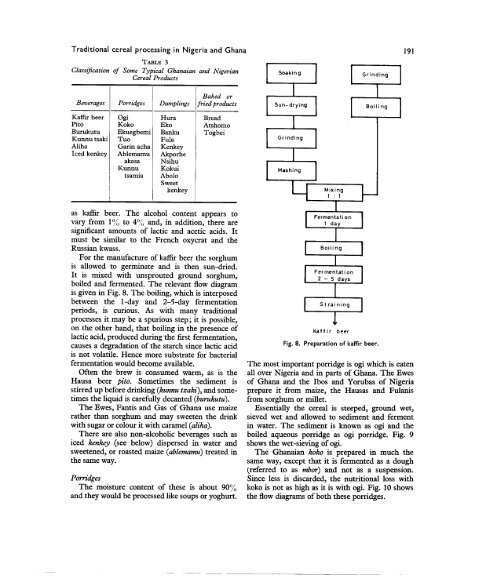Traditional cereal processing in Nigeria and Ghana
Traditional cereal processing in Nigeria and Ghana
Traditional cereal processing in Nigeria and Ghana
You also want an ePaper? Increase the reach of your titles
YUMPU automatically turns print PDFs into web optimized ePapers that Google loves.
<strong>Traditional</strong> <strong>cereal</strong> <strong>process<strong>in</strong>g</strong> <strong>in</strong> <strong>Nigeria</strong> <strong>and</strong> <strong>Ghana</strong><br />
TABLE 3<br />
Classification of Some Typical <strong>Ghana</strong>ian <strong>and</strong> <strong>Nigeria</strong>n<br />
Cereal Products<br />
Baked or<br />
Beverages Porridges Dumpl<strong>in</strong>gs fried products<br />
Kaffir beer Ogi Hura Bread<br />
Pito Koko Eko Atshomo<br />
Burukutu Ekuegbemi Banku Togbei<br />
Kunnutsaki Tuo Fula<br />
Aliha Gar<strong>in</strong> acha Kenkey<br />
Iced kenkey Ablemamu Akporhe<br />
akasa Nsihu<br />
Kunnu<br />
tsamia<br />
Kokui<br />
Abolo<br />
Sweet<br />
kenkey<br />
as kaffir beer. The alcohol content appears to<br />
vary from 1°/., to 4% <strong>and</strong>, <strong>in</strong> addition, there are<br />
significant amounts of lactic <strong>and</strong> acetic acids. It<br />
must be similar to the French oxycrat <strong>and</strong> the<br />
Russian kwass.<br />
For the manufacture of kaffir beer the sorghum<br />
is allowed to germ<strong>in</strong>ate <strong>and</strong> is then sun-dried.<br />
It is mixed with unsprouted ground sorghum,<br />
boiled <strong>and</strong> fermented. The relevant flow diagram<br />
is given <strong>in</strong> Fig. 8. The boil<strong>in</strong>g, which is <strong>in</strong>terposed<br />
between the I-day <strong>and</strong> 2-5-day fermentation<br />
periods, is curious. As with many traditional<br />
processes it may be a spurious step; it is possible,<br />
on the other h<strong>and</strong>, that boil<strong>in</strong>g <strong>in</strong> the presence of<br />
lactic acid, produced dur<strong>in</strong>g the first fermentation,<br />
causes a degradation of the starch s<strong>in</strong>ce lactic acid<br />
is not volatile. Hence more substrate for bacterial<br />
fermentation would become available.<br />
Often the brew is consumed warm, as is the<br />
Hausa beer pito. Sometimes the sediment is<br />
stirred up before dr<strong>in</strong>k<strong>in</strong>g (kunnu tzaki), <strong>and</strong> sometimes<br />
the liquid is carefully decanted (burukutu).<br />
The Ewes, Fantis <strong>and</strong> Gas of <strong>Ghana</strong> use maize<br />
rather than sorghum <strong>and</strong> may sweeten the dr<strong>in</strong>k<br />
with sugar or colour it with caramel (aliha).<br />
There are also non-alcoholic beverages such as<br />
iced kenkey (see below) dispersed <strong>in</strong> water <strong>and</strong><br />
sweetened, or roasted maize (ablemamu) treated <strong>in</strong><br />
the same way.<br />
Porridges<br />
The moisture content of these is about 90%<br />
<strong>and</strong> they would be processed like soups or yoghurt.<br />
The most important porridge is ogi which is eaten<br />
all over <strong>Nigeria</strong> <strong>and</strong> <strong>in</strong> parts of <strong>Ghana</strong>. The Ewes<br />
of <strong>Ghana</strong> <strong>and</strong> the Ibos <strong>and</strong> Yorubas of <strong>Nigeria</strong><br />
prepare it from maize, the Hausas <strong>and</strong> Fulanis<br />
from sorghum or millet.<br />
Essentially the <strong>cereal</strong> is steeped, ground wet,<br />
sieved wet <strong>and</strong> allowed to sediment <strong>and</strong> ferment<br />
<strong>in</strong> water. The sediment is known as ogi <strong>and</strong> the<br />
boiled aqueous porridge as ogi porridge. Fig. 9<br />
shows the wet-siev<strong>in</strong>g of ogi.<br />
The <strong>Ghana</strong>ian koko is prepared <strong>in</strong> much the<br />
same way, except that it is fermented as a dough<br />
(referred to as mbor) <strong>and</strong> not as a suspension.<br />
S<strong>in</strong>ce less is discarded, the nutritional loss with<br />
koko is not as high as it is with ogi. Fig. 10 shows<br />
the flow diagrams of both these porridges.








